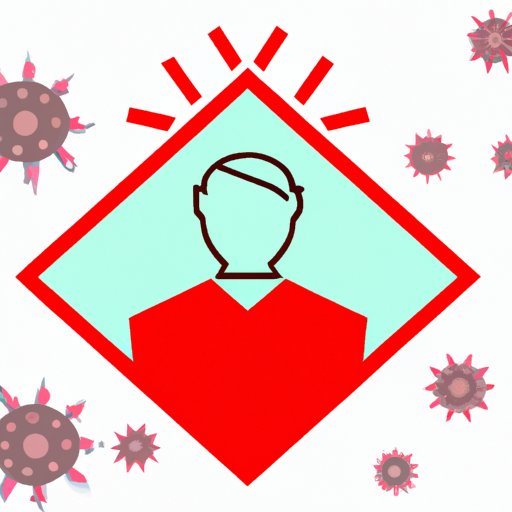Introduction
The flu is an infectious illness caused by the influenza virus. It is a highly contagious disease that can spread quickly among family members, colleagues, and classmates. Symptoms of the flu typically include fever, headache, sore throat, body aches, fatigue, and coughing. The flu is often confused with other respiratory illnesses, but it is important to distinguish between them in order to determine when someone is no longer contagious with the flu.
This article seeks to provide a comprehensive overview of when someone is no longer contagious with the flu. It will discuss signs and symptoms of contagion, factors affecting contagiousness, treatments to shorten the contagious period, vaccines and other preventative measures, and how to re-enter society after being contagious. By reading this article, readers should gain a better understanding of when they are no longer contagious with the flu and the steps they can take to reduce the risk of transmitting the virus.
Identifying the Signs and Symptoms of Flu Contagion
The first step in determining when someone is no longer contagious with the flu is to identify the signs and symptoms of contagion. Common symptoms of the flu include fever, chills, headache, muscle aches, sore throat, runny nose, and coughing. These symptoms usually appear 1 to 4 days after exposure to the virus and last for about a week.
If these symptoms are present, it is important to seek medical attention. A doctor can diagnose the flu using a physical exam and laboratory testing. It is important to be tested as soon as possible so that appropriate treatment can be started.

Understanding When You Are Most Contagious with the Flu
Once the flu has been diagnosed, it is important to understand when someone is most contagious with the virus. According to the Centers for Disease Control and Prevention (CDC), people with the flu are most contagious during the first 3 to 4 days after their symptoms begin. This is known as the contagious period.
There are several factors that can affect how long someone remains contagious with the flu. For example, young children may remain contagious for longer than adults, and people with weakened immune systems may also be contagious for longer periods of time. Additionally, some strains of the virus may be more contagious than others.
Knowing When the Contagious Period Is Over
Once the contagious period is over, it is important to know when someone is no longer contagious with the flu. Generally, the contagious period lasts for about 1 week. However, there are treatments available that can shorten this period. Antiviral medications, such as Tamiflu, can help reduce the duration of the contagious period.
In addition, other treatments, such as rest, fluids, and over-the-counter medications, can help relieve symptoms and shorten the contagious period. It is important to talk to a doctor before starting any treatment plan.
Exploring Treatment Options to Shorten the Contagious Period
Antiviral medications, such as Tamiflu, can help reduce the duration of the contagious period. These medications work by targeting the virus directly and helping the body fight the infection. They are most effective when taken within 48 hours of the onset of symptoms. If taken later than 48 hours, antiviral medications may still help reduce the severity and duration of symptoms.
Other treatments, such as rest, fluids, and over-the-counter medications, can also help relieve symptoms and shorten the contagious period. It is important to talk to a doctor before starting any treatment plan.

Examining Vaccines and Other Preventative Measures
Vaccines are the best way to prevent the flu. Vaccines are available for both adults and children, and they can reduce the risk of contracting the virus. There are two types of vaccines: inactivated (dead) viruses and live attenuated (weakened) viruses. Inactivated vaccines are given as shots, while live attenuated vaccines are given as nasal sprays.
In addition to vaccines, other preventative measures can help reduce the risk of contracting the flu. These measures include washing hands regularly, avoiding contact with people who are sick, and staying away from crowded places. It is also important to get enough sleep and exercise regularly.

Comparing the Flu to Other Respiratory Illnesses
It is important to distinguish between the flu and other respiratory illnesses. The flu is caused by the influenza virus, while other respiratory illnesses, such as colds, are caused by different viruses. Symptoms of the flu tend to be more severe than those of other respiratory illnesses and can include fever, chills, muscle aches, and fatigue.
However, there are some similarities between the flu and other respiratory illnesses. Both can cause a cough, sore throat, and runny nose. Additionally, both can be spread through contact with infected droplets from coughing or sneezing.
Discussing How to Re-enter Society After Being Contagious with the Flu
Once the contagious period is over, it is important to follow safety guidelines to prevent the spread of the virus. People should avoid contact with others until 24 hours after their fever has gone away without the use of fever-reducing medications. In addition, it is important to wash hands regularly and cover coughs and sneezes with a tissue.
It is also helpful to have a plan for re-integrating into society after being contagious with the flu. Some tips for doing this include getting plenty of rest, eating healthy foods, drinking lots of fluids, and avoiding contact with people who are at high risk of serious illness, such as the elderly or those with weakened immune systems.
Conclusion
The flu is a highly contagious virus that can spread quickly among family members, colleagues, and classmates. It is important to understand when someone is no longer contagious with the flu in order to prevent its spread. Signs and symptoms of the flu include fever, chills, headache, muscle aches, sore throat, runny nose, and coughing. People are typically most contagious during the first 3 to 4 days after their symptoms begin, and the contagious period usually lasts for about 1 week.
Treatments, such as antiviral medications and other over-the-counter medications, can help shorten the contagious period. Vaccines are the best way to prevent the flu, and other preventative measures, such as handwashing and avoiding contact with people who are sick, can also help reduce the risk of contagion. Finally, it is important to follow safety guidelines and have a plan for re-integrating into society after being contagious with the flu.
By reading this article, readers should gain a better understanding of when they are no longer contagious with the flu and the steps they can take to reduce the risk of transmitting the virus.
(Note: Is this article not meeting your expectations? Do you have knowledge or insights to share? Unlock new opportunities and expand your reach by joining our authors team. Click Registration to join us and share your expertise with our readers.)
